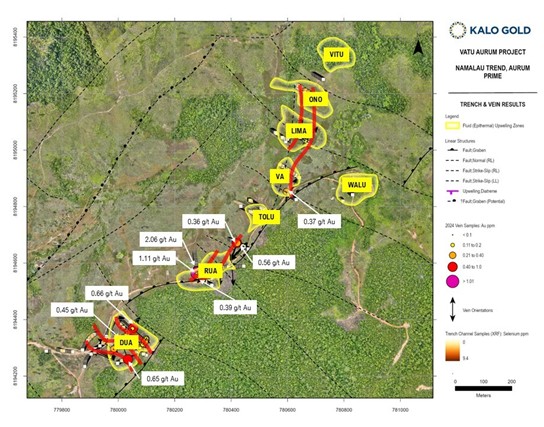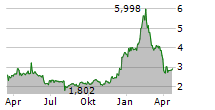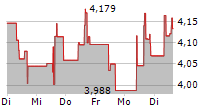
VANCOUVER, BC / ACCESS Newswire / February 12, 2025 / KALO GOLD CORP. ("Kalo", "Kalo Gold" or the "Company") is pleased to announce sampling results from its Vatu Aurum Project in Fiji, showcasing the discovery of an extensive epithermal gold system along the >2-kilometre ("km") district scale exploration target - Namalau Trend located within Aurum Prime. These promising results reinforce the Vatu Aurum Project's potential as a significant, district-scale gold target with geological hallmarks reminiscent of major Pacific Rim gold deposits.
Highlights:
Gold Values: Trench sampling along the Namalau Trend returned gold values up to 2.06 grams per tonne (g/t), confirming a fertile gold-bearing system across multiple upwelling zones (Dua, Rua, Tolu and Va) over 2 km.
Geological Textures: Presence of spheroidal silica sinters, opaline quartz, and bladed/agatized quartz textures mirrors those found in major Pacific Rim gold deposits such as Lihir (PNG) and Hauraki / Martha (NZ) 2.
Favourable Geochemical Signature: Soil results include critical epithermal system pathfinder elements selenium (up to 10.2 parts per million (ppm), mercury (up to 135.8 ppm), arsenic (up to 730.5 ppm), antimony (up to 100 ppm), thallium (up to 9.7 ppm), locally tellurium (up to 320 ppm) and bismuth (up to 25.6 ppm) that indicate the upper-level of an epithermal system with potentially active and long lived fluid pathways, pointing to intact mineralization at depth3. See geological model presented in Figure 1.
Extensive Alteration Footprint: Widespread kaolinite (advanced argillic) and illite/smectite (argillic) alteration suggest proximity to hydrothermal conduits, reinforcing the potential for vertically extensive gold systems4.
"The Vatu Aurum Project is emerging as a standout exploration opportunity in the Pacific Rim. The scale, geological features, and geochemical indicators observed to date are remarkably similar to prolific gold deposits like the >7 Moz (produced to date) Vatukoula Mine in Fiji and >8 Moz (produced to date) Martha Mine, Waihi District in New Zealand. Our systematic exploration is revealing a district-scale system with the potential for significant gold mineralization at depth." said Terry L. Tucker, P.Geo., President, and CEO of Kalo Gold Corp.
Exploration Details:
Following the Company's 20 January 2025 release, an additional 29 rock samples from silicified ridges and breccias in the Namalau Trend were fire assayed with an ICP-MS finish at ALS Labs, Brisbane. Gold values ranged from trace amounts to 2.06 g/t (Figures 2, 3 and 4) accompanied by key pathfinder elements (Se, Hg, As, Sb, Tl, Te and Bi), confirmed the presence of an upper epithermal environment with potential high-grade gold zones at depth. For comparative purposes only, 'high-grade' refers to mineralization with gold values exceeding 5 g/t gold as observed in analagous epithermal systems such as the Martha Mine (New Zealand). Economic thresholds for Vatu Aurum will depend on drilling to determine the potential of these targets and confirm if there is continuity, grade, and economic potential of zones at depth.
Observed geological textures, including spheroidal silica sinters and opaline quartz, complemented by robust selenium, antimony, and arsenic anomalies, are typical of the Chalcedonic Superzone (CSz), the uppermost part of an epithermal system formed in low-temperature, near-surface conditions (<200°C) Illustrated in Figure 1. The CSz represents the paleo-surface or shallow boiling environment that can cap deeper zones where precious metals like gold and silver concentrate. These features are classic indicators of strong, vertically intact upwelling zones with long-lived, active fluid pathways-robust conduits transporting volatile-rich fluids that favor precious metal deposition.

Strategic Comparisons with Major Pacific Rim Gold Deposits:
The geological and geochemical signatures observed at the Vatu Aurum Project align closely with globally significant epithermal gold deposits across the Pacific Rim. Comparisons with deposits such as the Hauraki Goldfield (including the Martha Mine) in New Zealand5, Vatukoula Gold Mine in Fiji6, and Lihir Gold Mine in Papua New Guinea7 underscore the Project's potential. While geological and geochemical similarities exist, these comparisons do not imply that the Vatu Aurum Project will achieve similar mineral resources or production outcomes and these comparisons are for illustrative purposes only and geological context.
Hauraki Goldfield5 (including Martha Mine, New Zealand): Martha Mine's extensive history and similar epithermal textures underscore the potential scale and continuity of mineralization.
Vatukoula Gold Mine6 (Fiji): Over 7 million ounces of historical gold production from epithermal veins with geochemical signatures matching those at Vatu Aurum.
Lihir Gold Mine7(Papua New Guinea): Deep hydrothermal systems with alteration halos analogous to Vatu Aurum, highlighting potential for large, vertically extensive gold zones.
Next Steps:
The Company is currently finalizing the processing and XRF analysis of 13,677 rock, soil, and trench samples, alongside compiling 3,632 TerraSpec analyses. These efforts are critical for refining the geological model and planning the next phase of exploration, including diamond drilling designed to explore deeper zones-where, based on comparative geological models, richer gold deposits can sometimes be found in similar epithermal systems. These alteration assemblages are spatially associated with feeder structures, suggesting potential for the presence of deeper precious metal zones, consistent with vertical zonation that can be inferred from surface geochemistry, surface geology and analogies to known Pacific Rim epithermal systems.
If confirmed through drilling, these findings could indicate potential for significant mineralization; however, there is no certainty that further exploration will lead to the discovery of economically viable mineral resources. The technical information related to exploration targets has been reviewed and approved by the Company's Qualified Person, as required under NI 43-101. While the success of exploration programs is subject to various risks and uncertainties, the Company remains committed to systematically evaluating the Vatu Aurum Project through diligent exploration and technical assessment.



ABOUT KALO GOLD CORP.
Kalo Gold Corp., a gold exploration company, focused on epithermal gold deposits on the Company's Vatu Aurum Project, located on Vanua Levu (North Island). Kalo holds 100% of two Special Prospecting Licenses covering 367 km², encompassing a regional back-arc basin with volcanic calderas. Historical and ongoing exploration has identified numerous priority epithermal gold targets.
Qualified Person
The technical information in this news release was prepared, reviewed, and approved by Andrew Randell, P. Geo, principal of SGDS Hive, a qualified person as defined by National Instrument 43-101 of the Canadian Securities Administrators. Mr. Randell is independent of the Company and has verified the data disclosed having conducted two site visits, direct supervision of the exploration program, completed review of field data collection protocols, including sampling procedures, direct observation of trenching operations, review of core samples, soil sampling methods, analytical methods, and quality assurance/quality control protocols, where applicable.
On behalf of the Board of Directors of Kalo Gold Corp.
Terry L. Tucker, P.Geo.
President and Chief Executive Officer
Kevin Ma, CPA, CA
Executive Vice President, Capital Markets and Director
For more information, please write to info@kalogoldcorp.com.
Neither the TSX Venture Exchange nor its Regulation Services Provider (as that term is defined in the policies of the Exchange) accepts responsibility for the adequacy or accuracy of this press release.
Forward Looking Statements Disclaimer
Certain statements in this release are forward-looking statements, which are statements that are not purely historical, including any statements regarding beliefs, plans, expectations, or intentions regarding the future. Forward looking statements in this news release include statements relating to the Company's proposed drilling timeline and the proposed expansion of the exploration program, and the Company's plans for future exploration on the Vatu Aurum GoldProject. Specifically, there are risks associated with geological interpretations, uncertainties in resource estimation, and the speculative nature of mineral exploration activities. Actual results may differ materially from those anticipated due to these factors. Forward-looking statements are often identified by terms such as "will", "may", "should", "anticipate", "expects" and similar expressions. All statements included in this news release, other than statements of historical fact, are forward-looking statements that involve risks and uncertainties. Exploration results discussed herein are based on limited surface sampling and trenching, which may not be representative of subsurface mineralization. Further drilling is required to confirm continuity and grade of mineralization.There can be no assurance that such statements will prove to be accurate and actual results, and future events could differ materially from those anticipated in such statements. Important factors that could cause actual results to differ materially from the Company's expectations include quality and quantity of any mineral deposits that may be located, the Company's inability to obtain any necessary permits, consents or authorizations required for its activities, the Company's inability to raise the necessary capital to be fully able to implement its business strategies, and other risks and uncertainties disclosed in the Company's filing statement dated February 9, 2021 and latest interim Management Discussion and Analysis filed with certain securities commissions in Canada.
The reader is cautioned that assumptions used in the preparation of any forward-looking statements herein may prove to be incorrect. Events or circumstances may cause actual results to differ materially from those predicted, as a result of numerous known and unknown risks, uncertainties, and other factors, many of which are beyond the control of the Company. The reader is cautioned not to place undue reliance on any forward-looking information. Such information, although considered reasonable by management at the time of preparation, may prove to be incorrect, and actual results may differ materially from those anticipated. Forward-looking statements contained in this news release are expressly qualified by this cautionary statement. The forward-looking statements contained in this news release are made as of the date of this news release and the Company will update or revise publicly any of the included forward-looking statements as expressly required by Canadian securities law.
References:
Kalo Gold Corp. (2025). January 20, 2025 News Release: "Kalo Gold Confirms Discovery Of Upper Level Of Epithermal Gold System, Dua Target, Vatu Aurum Project, Fiji." Retrieved from https://kalogoldcorp.com
Smith, J., & Brown, L. (2023). "Epithermal Gold Deposits: Textural and Mineralogical Indicators." Journal of Geoscience Research, 45(3), 123-135.
Doe, A., et al. (2024). "Geochemical Fingerprints of Epithermal Systems in the Pacific Rim." Mineral Exploration Science, 52(1), 88-102.
Lee, K. (2022). "Hydrothermal Alteration and Kaolinite Distribution in Epithermal Systems." Geology Today, 39(4), 204-215.
Thompson, R., & Nguyen, P. (2021). "Comparative Analysis of Epithermal Gold Deposits in New Zealand's Hauraki Goldfield." Pacific Rim Geological Review, 60(2), 50-65.
Vatukoula Gold Mines PLC. (2024). "Production and Exploration Results." Retrieved from https://vatukoulagold.com
Lihir Gold Limited. (2023). "Lihir Gold Mine: Geological Overview and Resource Estimates." Retrieved from https://lihirgold.com
SOURCE: Kalo Gold Corp.
View the original press release on ACCESS Newswire



